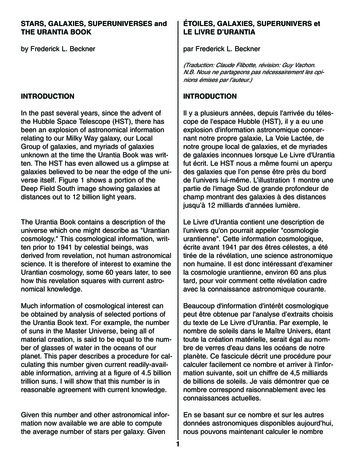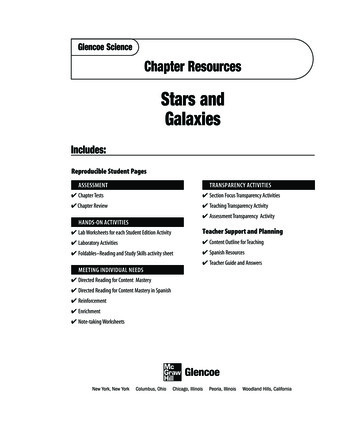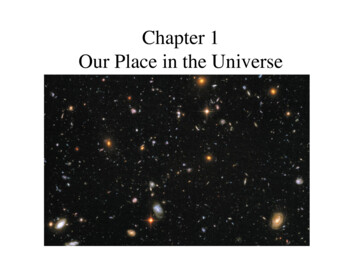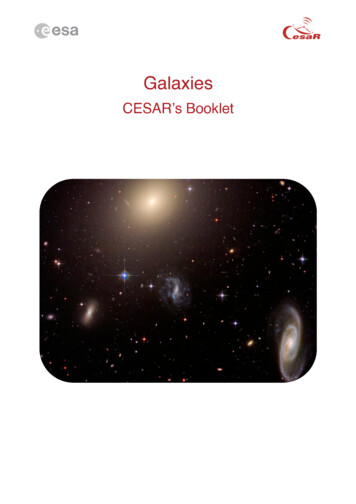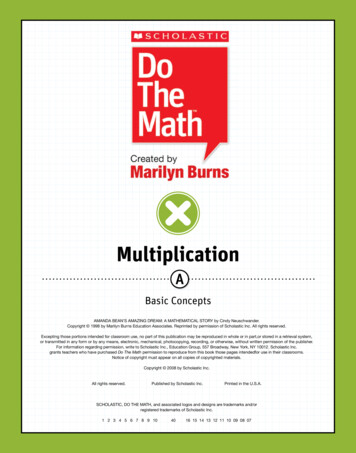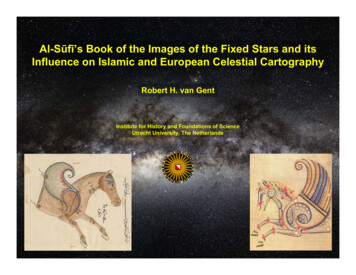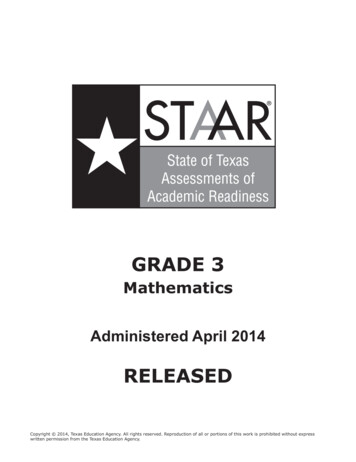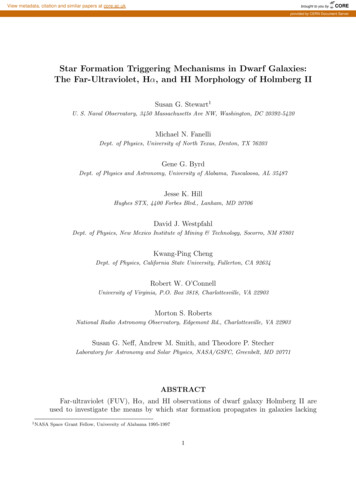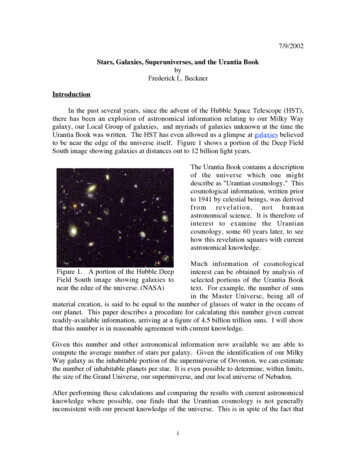
Transcription
7/9/2002Stars, Galaxies, Superuniverses, and the Urantia BookbyFrederick L. BecknerIntroductionIn the past several years, since the advent of the Hubble Space Telescope (HST),there has been an explosion of astronomical information relating to our Milky Waygalaxy, our Local Group of galaxies, and myriads of galaxies unknown at the time theUrantia Book was written. The HST has even allowed us a glimpse at galaxies believedto be near the edge of the universe itself. Figure 1 shows a portion of the Deep FieldSouth image showing galaxies at distances out to 12 billion light years.The Urantia Book contains a descriptionof the universe which one mightdescribe as "Urantian cosmology." Thiscosmological information, written priorto 1941 by celestial beings, was derivedfrom revelation, not humanastronomical science. It is therefore ofinterest to examine the Urantiancosmology, some 60 years later, to seehow this revelation squares with currentastronomical knowledge.Much information of cosmologicalinterest can be obtained by analysis ofselected portions of the Urantia Booktext. For example, the number of sunsin the Master Universe, being all ofmaterial creation, is said to be equal to the number of glasses of water in the oceans ofour planet. This paper describes a procedure for calculating this number given currentreadily-available information, arriving at a figure of 4.5 billion trillion suns. I will showthat this number is in reasonable agreement with current knowledge.Figure 1. A portion of the Hubble DeepField South image showing galaxies tonear the edge of the universe. (NASA)Given this number and other astronomical information now available we are able tocompute the average number of stars per galaxy. Given the identification of our MilkyWay galaxy as the inhabitable portion of the superuniverse of Orvonton, we can estimatethe number of inhabitable planets per star. It is even possible to determine, within limits,the size of the Grand Universe, our superuniverse, and our local universe of Nebadon.After performing these calculations and comparing the results with current astronomicalknowledge where possible, one finds that the Urantian cosmology is not generallyinconsistent with our present knowledge of the universe. This is in spite of the fact that1
the Urantia Book states that it's cosmology is not divinely inspired and may requirerevision in the future.“The cosmology of these revelations is not inspired. It is limited by ourpermission for the co-ordination and sorting of present-day knowledge.”(UB1109:3)Urantian CosmologyAn overview of Urantian cosmology is given on the first page of the Urantia Book.“Your world, Urantia, is one of many similar inhabited planets whichcomprise the local universe of Nebadon. This universe, together withsimilar creations, makes up the superuniverse of Orvonton, from whosecapital, Uversa, our commission hails. Orvonton is one of the sevenevolutionary superuniverses of time and space which circle the neverbeginning, never-ending creation of divine perfection--the central universeof Havona. At the heart of this eternal and central universe is thestationary Isle of Paradise, the geographic center of infinity and thedwelling place of the eternal God.The seven evolving superuniverses in association with the central anddivine universe, we commonly refer to as the grand universe; these are thenow organized and inhabited creations. They are all a part of the masteruniverse, which also embraces the uninhabited but mobilizing universes ofouter space.” (UB1:5-6)We thus live in the grand universe, which includes the presently-inhabited portion of themuch larger master universe. The grand universe is subdivided into sevensuperuniverses, or collections of galaxies, one for each of the seven possible MasterSpirits, or personality associations of the three triune manifestations of God. The seventhMaster Spirit, being the association of the Universal Father, Eternal Son, and InfiniteSpirit supervises our superuniverse of Orvonton. We will show that the Milky Waygalaxy lies entirely within Orvonton, and is the greatest part of the inhabited portion ofOrvonton. The capital of our superuniverse is called Uversa and will be shown to belocated outside the Milky Way galaxy.“Satania has a headquarters world called Jerusem, and it is system numbertwenty-four in the constellation of Norlatiadek. Your constellation,Norlatiadek, consists of one hundred local systems and has a headquartersworld called Edentia. Norlatiadek is number seventy in the universe ofNebadon. The local universe of Nebadon consists of one hundredconstellations and has a capital known as Salvington. ” (UB182:5)2
We also live in a star system called Satania, presumably named after Satan, a lieutenantand associate of Lucifer, a former ruler of Satania, who led a rebellion against God,which resulted in the isolation of our planet, Urantia, from the rest of the universe.Jerusem is said to be an architectural sphere, or artificial world, and thus is nonluminousand is not visible by telescopic means from Urantia. It is of special interest because it ison a subsatellite of a satellite of Jerusem that we are resurrected after death. This is thelocation of the mansion worlds mentioned by Jesus.Our star system of Satania is one of approximately 10,000 such systems in our localuniverse of Nebadon. This local universe was created by a Creator Son of God, Michael,who incarnated on Urantia to live the life of one of His mortal creatures and to reveal thenature of God the Father to the inhabitants of His local universe. Michael is better knownon Urantia as His mortal incarnation, Jesus of Nazareth. The Urantia Book specificallysays that our local universe of Nebadon is not a physical star system, but that its capital,Salvington, is within such a system. We will show that our local universe isapproximately 4000 light years in diameter.With this brief overview of Urantian cosmology, we are now prepared to examinespecific teachings of the Urantia Book and to compare them with current astronomicalknowledge.The Master UniverseSize of the Master UniverseThe Urantia Book does not explicitly give a size for the master universe. It does implythat the master universe is finite and is expanding."Even if the master universe eventually expands to infinity " (UB92:6)Curent scientific estimates of the size of the master universe are generally based on thetheory of the "big bang" where the universe came into being at an instant of time about14 billion years ago, and has expanded outwards from this point at the speed of light eversince. A good discussion of three techniques for determining this age is given athttp://www.astro.ucla.edu/ wright/age.html. Under these assumptions, it is thus a spherehaving a radius of about 14 billion light years.The Urantia Book implicitly denies the big bang theory, for it implies that the masteruniverse was already in existence 875 billion years ago. It was at this time theAndronover nebula was initiated which resulted in our local universe of Nebadon."875,000,000,000 years ago the enormous Andronover nebula number876,926 was duly initiated." (UB652:2)3
Number of Stars in the Master UniverseThe Urantia Book contains the following statement about the number of stars in themaster universe.“But in the master universe there are as many suns as there are glasses ofwater in the oceans of your world.” (UB173:0)The volume of the oceans of Urantia can be found on the United States GeologicalSurvey web site, www.usgs.gov/edu/waterdistribution.html, as 317 million cubic miles.Knowing this, and that one cubic mile is equivalent to 4.167 x 109 cubic meters, one findsthat the volume of water on Urantia is 1.321 x 1018 m3 or 1.321 x 1024 cm3.Another source states that the oceans cover 70 percent of the earth’s surface and have anaverage depth of 2 miles. The area of the earth’s surface is 4 pi times the square of theearth’s radius of 6,350 km. Given this, one can calculate that the volume of this water is1.14 x 1024 cm3, which is in substantial agreement with the volume given by the USGS.To compute the number of stars in the master universe we need a number for the volumeof a glass of water. A small juice glass in my kitchen has a volume of 200 cm3. A typicaldrinking glass that I use daily has a volume of 300 cm3, and the volume of the largestglass I have is 500 cm3. Thus, taking the volume to be 300 cm3 will give results accurateto within about /- 40%, a figure sufficient for our purposes. Given that the volume of atypical glass of water is about 300 cm3, one can calculate that the number of glasses ofwater in the oceans of Urantia is about 4.4 x 1021. Thus, according to the Urantia Book,the number of suns in the master universe must be on the order of 4.4 x 1021. The website, Atlas of the Universe (http://anzwers.org/free/universe/universe.html), states thatthere are 2.0 x 1021 stars in the visible universe.To put this number in perspective consider that a cubic rock salt crystal 0.92 cm (0.36inches) on an edge will contain the same number of molecules. This can be calculatedgiven that rock salt is a cubic crystal with a lattice constant of 5.64 x 10-8 cm. We canconclude that the number of atoms in the human body is much greater than the number ofstars in the universe.The Mass of the Master UniverseGiven the number of stars in the master universe it is possible to estimate its mass. Giventhat the sun is an average star, and the mass of the sun is 1.989 x 1033 g (grams), then themass of all the stars in the master universe would be 4.4 x 1021 * 1.989 x 1033 9 x 1054 g.Currently astronomers believe that more than 90% of the mass of the universe is tied upin “dark matter.” Thus the mass of the universe would be about ten times the mass of allthe visible stars, or about 9 x 1055 g.4
Eddington, in his book, Fundamental Theory (1946, p 105), computes the mass of theuniverse from general relativistic theory as 1.98 x 1055 g which is within a factor of 4.5 ofthe value inferred from UB statements. Thus these estimates agree within an order ofmagnitude, although we have no proof that either Eddington’s value or the UB value iscorrect. Eddington also computes the number of protons in the universe to be 3/2 * 2256 *136 2.36 x 1079 (p283).Number of Galaxies in the Master UniverseThe Urantia Book discusses the number of galaxies in the master universe in thefollowing quote.“In the not-distant future, new telescopes will reveal to the wonderinggaze of Urantian astronomers no less than 375 million new galaxies in theremote stretches of outer space.” (UB130:5)The Urantia Book is probably referring here to the Hale (Mt Palomar) telescope, whichwent into operation in 1948. The figure 375 million thus refers to the additional newgalaxies observable when the Hale telescope was put into operation, not the number ofgalaxies in the master universe. Recently the Hubble Space Telescope made two deepfield images, in the region of the North Pole, and another in the region of the South Pole(see Figure 1), these regions being those which could be continuously observed for longperiods of time without interruption by occultation by the Earth. Exposure times of 10days were used. From the north deep field image astronomers estimate that there are 80billion galaxies in the universe. From the southern image they estimate that there are 125billion galaxies in the universe. For the purposes of this paper we will assume that thereare at least 100 billion galaxies in the master universe.Number of Stars Per GalaxyGiven this number of galaxies and the total number of stars in the master universe, onecan calculate that the average number of stars per galaxy is 4.4 x 1021 stars divided by 1.0x 1011 galaxies or 4.4 x 1010 stars per galaxy (44 billion). The number of stars in ourMilky Way galaxy is estimated to be around 200 to 400 billion. This is pretty goodagreement with our average number since our galaxy is the second largest in our localcluster of about 30 galaxies, and thus may be considered to be an exceptionally largegalaxy. There are many more small galaxies of the elliptical or globular types than thereare of the spiral type such as our Milky Way. The information on the number of stars inthe Milky Way was obtained from the University of Arizona .5
Density of Stars in the Master UniverseIf there are 4.4 x 1021 stars in the master universe and if the radius of the master universeis 14 billion light years, then the average density of stars in the master universe is 3.8 x10-10 stars per cubic light year. If the stars were uniformly distributed throughout themaster universe the minimum distance between stars would be about 1,400 light years.Actually, the stars cluster into globular clusters, galaxies, clusters of galaxies, andgalactic superclusters where the stellar density is significantly greater than the averagedensity, and leaving great voids in which the stellar density is much less than average.Given knowledge of the density of stars in a given region, it is possible to estimate thevolume of the sphere necessary to contain a given number of stars, and from this todetermine the approximate radius of this sphere. This technique will be used later tocompute radii for the grand universe, our superuniverse, and our local universe.The Grand Universe and OrvontonSize of the Grand UniverseThe size of the grand universe can be estimated from the number of stars it contains andan estimate of the average star density on that scale. The Urantia Book says there are tentrillion stars in our superuniverse (UB172:7). If we assume that all seven superuniversesare of approximately the same size, then there would be 70 trillion stars in the granduniverse.If the grand universe contains seventy trillion stars, and if these stars are in galaxieswhich are approximately uniformly distributed throughout the master universe, then thevolume of space occupied by the grand universe will be a fraction 70 x 1012/4.4 x 1021 1.59 x 10-8 of the volume of the master universe. The current estimate of the radius of themaster universe is about 14 billion light years. Since the volume is proportional to theradius cubed, the radius of the grand universe would be of the order of (1.59 x 10-8)0.333 2.5 x 10-3 times the radius of the master universe, or about 35 million light years. Thisassumes that the star density in the Grand Universe is the same as in the Master Universe.There is good reason to believe that the actual star density within our local part of theuniverse is considerably higher than the average density throughout the master universe.This is because the stars are grouped into galaxies, clusters of galaxies, and even largersuperclusters of galaxies leaving other areas with voids containing relatively fewgalaxies. We may estimate the average density of stars in our local group of galaxies inthe following manner.One source, the Atlas of the Universe, es that there are about 700 x 109 stars within 5 million light years of Earth. Thedensity of stars in this volume is thus about 1.3 x 10-9 per cubic light year, or about 3.3times the average density of the master universe. The same source gives the density in a6
sphere of about 1 billion light years as 1.19 x 10-10 per cubic light year. Thus this sourceestimates that the star density in our local area is about 10 times greater than that in avolume much greater than the volume of any supercluster. Given this, we must reduceour estimate of the size of the grand universe by a factor of the cube root of ten (10.333 2.15) to allow for the higher local density of stars. Our corrected estimate of the radius ofthe grand universe is then 35/2.15 16 million light years.Since Havona is at the center of the grand universe, the distance from Earth to Havonawould be about 16 million light years. If there are seven superuniverses distributedequally in angle about Havona, then the distance to the nearest superuniverse outsideOrvonton would be about 14 million light years.Another clue to the size of the grand universe is given in the following passage:"Long before the presence of life on Urantia the [Solitary] messenger nowassociated with me was assigned on a mission out of Uversa to the centraluniverse--was absent from the roll calls of Orvonton for almost a millionyears but returned in due time with the desired information." (UB259:2)The time given in this passage is most likely given in Uversa years, since the writers ofthe book seem to be quite explicit when they refer to Urantia years, calling such timeseither "Urantia years" or "years of Urantia time" 23 times throughout the book. Since theSolitary Messengers can travel at the rate of 4.52 million light years per Urantian year(UB267:1) and assuming the time given is in Uversa years (8.2 Urantia years, seeUB174:2) the distance traveled by the Solitary Messenger would be less than 37 trillionlight years. The distance to Havona would then be less than 18.5 trillion light years. Thiswould be in good agreement with the value derived above from the number of stars inOrvonton if the Solitary Messenger had been absent only one Uversa year rather than onemillion years.Number of Stars in OrvontonThe Urantia Book specifically gives the number of suns within Orvonton.“The superuniverse of Orvonton is illuminated and warmed by more thanten trillion blazing suns.” (UB172:7)This number of suns is indicative that Orvonton is composed of more than one galaxy,since the Milky Way, the second largest galaxy within the Local Group, is currentlythought to contain about 200 to 400 billion stars. It would take at least 25 Milky Way orabout 110 average galaxies to contain ten trillion stars. It is thus clear that oursuperuniverse of Orvonton is significantly bigger than our local group of about 30galaxies and is much bigger than the Milky Way galaxy.7
The Size of OrvontonThe Urantia Book gives at least seven different clues as to the size of our superuniverse,Orvonton.“Although the unaided human eyecan see only two or three nebulaeoutside the borders of thesuperuniverse of Orvonton, yourtelescopes literally reveal millionsupon millions of these physicaluniverses in process of formation.”(UB130:4)The galaxy M81, shown in Figure 2, isvisible to the unaided eye under verygood viewing conditions. This 6.9magnitude galaxy is 12 million lightyears distant and is probably not withinOrvonton. It is a candidate for beinganother of the seven superuniverses.Figure 2. The galaxy M81 is just visible tothe naked eye under ideal conditions.(SEDS)This passage clearly delineates thespatial extension of Orvonton, since issays that the unaided human eye cansee nebulae outside Orvonton. Thismeans that the many galaxies visibleby means of the telescope are notwithin Orvonton.This passagecontinues saying“Most of the starry realms visually exposed to the search of your present-daytelescopes are in Orvonton, but with photographic technique the larger telescopespenetrate far beyond the borders of the grand universe into the domains of outerspace, where untold universes are in process of organization.” (UB130:4)This sentence says that most the stars visible by eye through large telescopes are withinOrvonton. This is one of the primary distinguishing characteristics of the galaxies withinthe Local Group; that they contain individual stars which are visible by aid of a telescope.An implication of this sentence is that some of these starry realms are outside ofOrvonton. Thus some of the Local Group galaxies are outside of Orvonton. For moreinformation on the Local Group refer to the web page of the University of Arizona Lunarand Planetary Laboratory, l.The upper limit on the radius of the grand universe of 16 million light years also impliesan upper limit on the size of our superuniverse, Orvonton. If the seven superuniverses8
are spherical, equal in size, do not overlap, and are evenly distributed in a circle of radiusequal to 16 million light years, then the radius of each superuniverse must be smaller thanabout 8 million light years. This must be considered to be an extreme upper limit to thesize of Orvonton.Another estimate of the size of Orvonton can be obtained in the same manner as ourestimate of the size of the grand universe. If Orvonton contains 10 trillion stars, and ifthere are 4.4 x 1021 stars evenly distributed in the master universe, then a volume of spacewith a radius of 15.5 million light years would be required to hold this number of stars.Making the same correction for the difference between the local star density and that ofthe average density in the universe gives a radius of Orvonton of 15.6/2.15 7.2 millionlight years.The statement that the Divine Counselor can reach any part of the superuniverse in lessthan one year implies that the radius of the superuniverse must be less than 4.5 millionlight years. Assuming that Urantia and Jerusem are in the relative close proximity of2000 light years, then the radius of Orvonton must be less than 3.35 times 1.35 millionlight years, or 4.5 million light years.Another limit to the size of Orvonton can be derived from a passage concerning thephysical-energy circuits.“The power centers and physical controllers of the superuniverses assumedirection and partial control of the thirty energy systems which comprisethe gravita domain. The physical-energy circuits administered by thepower centers of Uversa require a little over 968 million years to completethe encirclement of the superuniverse.” (UB175:5)This passage seems to indicate that the circumference of the superuniverse is 968 millionlight years. This would indicate that the radius of the superuniverse is 154 million lightyears. This value is inconsistent with our previously derived information about the sizeof the superuniverse. The value of 968 million years could be the sum of the travel timesfrom the center of the superuniverse to the outer circumference, around thecircumference, and back to the center, for all 30 energy systems. Assuming this, and ifthese circuits all travel at the velocity of light, then the radius of the superuniverse wouldbe about 3.9 million light years. This value is consistent with our other information.The size of Orvonton can be estimated from the passage that implies that no less than 4%of the volume of Orvonton is inhabited (UB121:5). From this, and assuming thatOrvonton is roughly spherical we may infer that the ratio of the radius of Orvonton to thatof the inhabited portion of Orvonton is no less than 2.92. Given that the radius of theinhabited portion of Orvonton is 250,000 light years (UB359:8), then the radius ofOrvonton is not less than 730,000 light years.Another indication of the size of Orvonton comes from the information given in the UBon the Andromeda galaxy. If Andromeda is within Orvonton as indicated by the UB, and9
if the distance to Andromeda is 1 million light years, then the radius of Orvonton must beat least 500 thousand light years.Given the above considerations, one may conclude that the radius of Orvonton is greaterthan 730,000 and less than 4 million light years, possibly about 3 million light years.This would include the large Andromeda and Triangulum galaxies as well as a greatnumber of other smaller galaxies necessary to give the stated number of stars.The Milky Way Galaxy is within OrvontonThe Urantia Book indicates that our Milky Way galaxy is within the superuniverse ofOrvonton.“Practically all of the starry realms visible to the naked eye on Urantiabelong to the seventh section of the grand universe, the superuniverse ofOrvonton. The vast Milky Way starry system represents the centralnucleus of Orvonton, being largely beyond the borders of your localuniverse. This great aggregation of suns, dark islands of space, doublestars, globular clusters, star clouds, spiral and other nebulae, together withmyriads of individual planets, forms a watchlike, elongated-circulargrouping of about one seventh of the inhabited evolutionary universes.”(UB167:3)One-seventh of the inhabited evolutionary universes (I take this to mean local universes)may very well mean that the Milky Way contains nearly the entire inhabited portion ofOrvonton, which is one-seventh of the superuniverses in the grand universe.The idea that the Milky Way galaxy is within the superuniverse of Orvonton is madeeven more specific in the following passage.“They [the short space rays] emanate in the largest quantities from thedensest plane of the superuniverse, the Milky Way, which is also thedensest plane of the outer universes.” (UB475:1)This passage can also be read to imply that the other outer universes (the other sixsuperuniverses) lie in the plane of the Milky Way galaxy. It can also be read as implyingthat the Milky Way galaxy is the superuniverse of Orvonton, but this interpretation isinconsistent with the statement that Orvonton contains ten trillion stars, which is muchlarger than the 200 to 400 billion stars in the Milky Way.We may infer that other nebulae (galaxies) outside the Milky Way belong to Orvontonfrom the passage“some of the nebulae which Urantian astronomers regard as extragalacticare actually on the fringe of Orvonton and are traveling along with us.”(UB131:0)10
The Andromeda and Triangulum galaxies and the Large and Small Magellanicclouds are examples of such nebulae which are extragalactic (outside the MilkyWay galaxy) but which are part of Orvonton.The following passage indicates that there are at least seven galaxies in Orvonton.“Of the ten major divisions of Orvonton, eight have been roughlyidentified by Urantian astronomers. The other two are difficult of separaterecognition because you are obliged to view these phenomena from theinside. If you could look upon the superuniverse of Orvonton from aposition far-distant in space, you would immediately recognize the tenmajor sectors of the seventh galaxy.” (UB167:8)One can presume that they are talking about the Milky Way galaxy as the seventh galaxyin Orvonton. These ten major sectors also presumably refer to ten arms of our spiralgalaxy. In one visualization of the spiral arms of the Milky Way l) I can count only eight arms. TheAtlas of the Universe site gives the names of six arms of our galaxy: the Cygnas, Perseus,Orion, Sagittarius, Scutum-Crux, and Norma arms. At this time we cannot exclude thepossibility of their being ten arms, since much of the structure of our galaxy is hiddenfrom us by dust clouds, radio observations being the only practical way to observe behindthese clouds.The Small and Large MagellanicClouds are within OrvontonFigure 3. The Small Magellanic Cloudlocated 210,000 light years from the center ofthe Milky Way lies within the inhabitedportion of our superuniverse, Orvonton.11Two nearby extragalactic nebulawhich were known before theinvention of the telescope are theLarge and Small Magellanic Clouds,which were noted by Magellan in1519 during his voyages in thesouthern oceans.The SmallMagellanic Cloud, shown in Figure3, is at a distance of about 210,000light years, while the LargeMagellanic Cloud is only 179,000light years away. Being at adistance of less than 250,000 lightyears from the center of the MilkyWay puts them within the inhabitedportion of Orvonton.
Uversa, the Capital of Orvonton, is not within the Milky WayThe Urantia Book gives the distance from our system capital of Jerusem to the center ofthe superuniverse of Orvonton. This distance corresponds to the distance to the SmallMagellanic Cloud. Thus it is possible, although not likely as we will show later, thatUversa is within the SMC." The Satania system of inhabited worlds is far removed from Uversa andthat great sun cluster which functions as the physical or astronomic centerof the seventh superuniverse. From Jerusem, the headquarters of Satania,it is over two hundred thousand light-years to the physical center of thesuperuniverse of Orvonton, far, far away in the dense diameter of theMilky Way. Satania is on the periphery of the local universe, and Nebadonis now well out towards the edge of Orvonton. From the outermost systemof inhabited worlds to the center of the superuniverse is a trifle less thantwo hundred and fifty thousand light-years. " (UB359:8)Being at a distance of 210,000 light years from the center of the Milky Way, the SmallMagellanic Cloud is certainly “over two hundred thousand light-years” from Jerusem,and thus might be a candidate for the location of Uversa. The Small Magellanic Clouddoes not, however, seem to be centrally located with respect to the three largest nearbygalaxies, the Milky Way, Andromeda (M31), and Triangulum (M33). One must read"far, far away in the dense diameter of the Milky Way" as indicating a direction relativeto Jerusem, rather than a position. This would be consistent with accepted astronomicalusage of the word "in", as meaning in the same direction. Thus a planet is said to be "in"Aquarius, etc. To specifically locate the center of the superuniverse at the center of theMilky Way galaxy, one would use the words "at the center of" rather than "in."Taking the center of the superuniverse at the center of the Milky Way galaxy would beinconsistent with current knowledge in that the disk of the Milky Way is about 120,000light years in diameter, and that Urantia (and presumably Satania) is about 26,000 lightyears from the center of the galaxy. Thus the distance from Satania to the center of thesuperuniverse would likely be slightly less than 26,000 light years, and not over 200,000light years as stated. We thus conclude that the center of the superuniverse of Orvontonis not within the Milky Way galaxy.Uversa is not Near the Center of the Milky WayA Divine Counselor of Uversa states that he required 109 days t
Urantia Book was written. The HST has even allowed us a glimpse at galaxies believed to be near the edge of the universe itself. Figure 1 shows a portion of the Deep Field South image showing galaxies at distances out to 12 billion light years. The Urantia Book contains a description of the universe which one might describe as "Urantian .

